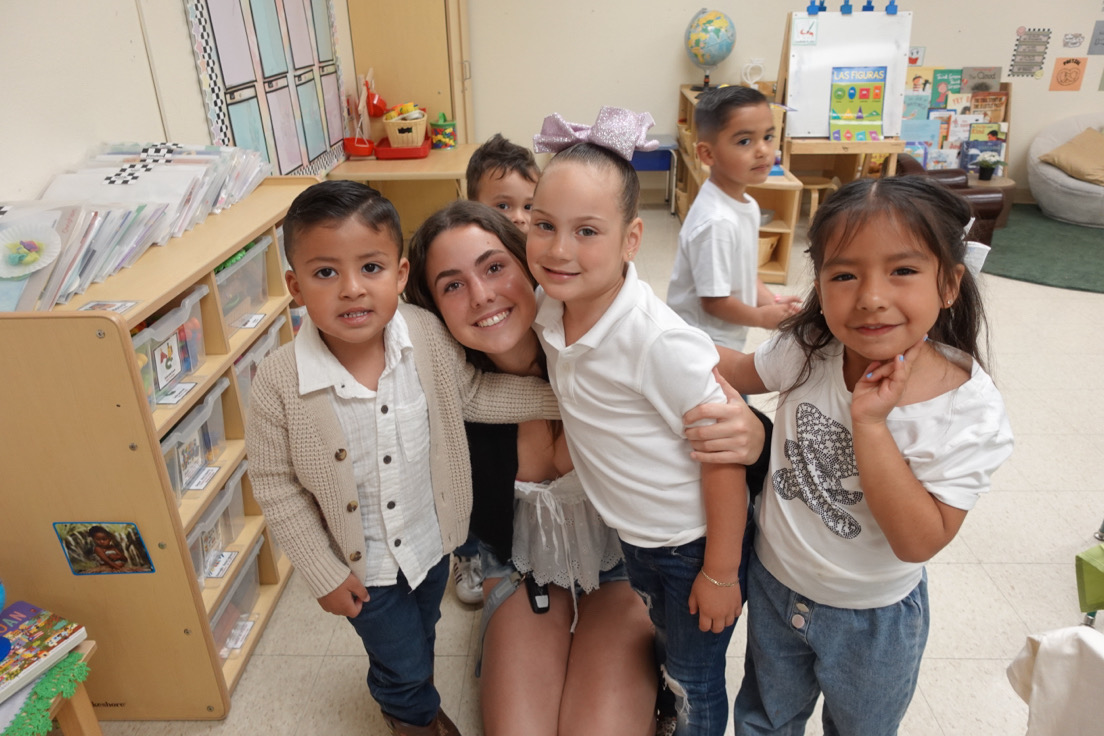Just 30 miles south of Bishop’s, in San Ysidro, California, almost 100,000 people cross the U.S.-Mexico border each day. With wait times lasting anywhere from two hours to all day, it is the world’s busiest land border crossing. From the headache of bringing correct documentation to standing in long lines, it may seem as if crossing the border is the hardest part of traveling to Mexico.
But at Bishop’s, the challenges of traveling across the border are not only in San Ysidro but also on campus, with the School only permitting an official trip across the border if it meets many requirements, ranging from charter transportation and possible private security to insurance that covers ransom, extortion, and kidnapping, according to Director of Global Education and Religion & Ethics Teacher Dr. David Moseley, who has organized nine global trips at Bishop’s to parts of the developing world since 2008.
Mia Gover (‘25) and her father, Justin Gover, recently encountered these hurdles firsthand while trying to plan an official trip to one of Corazón De Vida’s orphanages in the Baja region of Mexico. Their plight to organize a service trip across the border and over the School’s ‘red tape’ was put on center stage, with many students and faculty who are interested in planning trips across the border, such as Kesav Gupta (‘27), Declan O’Donovan (‘25), and Reverend Nicole Simopoulos-Pigato, watching closely.
Mia and Mr. Gover first discovered Corazón De Vida on a trip to the orphanage last spring. “When I went for the first time, it was so eye-opening, so impactful. Realizing that we are so close to that world, and yet it is so different and disconnected, really changed my perspective on how we view and engage with Mexico,” Mia reflected.
After their first trip, Mia and Mr. Gover immediately thought it was something that should be offered to the Bishop’s community. “There was and still is a clear interest among the Bishop’s community and families to foster awareness, relationships, and understanding of the border and what goes on across the border,” Mia explained. “So we thought this trip would be a great way to introduce Bishop’s families to the border through a trusted organization with an amazing cause and mission.”
So, Mia and Mr. Gover put together a trip proposal and reached out to Dr. Moseley and Reverend Simopoulos-Pigato, who had indicated interest in planning trips and forming connections with organizations at and across the border. They met to see if the School would be interested in planning a future trip to one of Corazón De Vida’s orphanages, in hope of starting to “foster a relationship between the organization and the School,” as Mr. Gover put it.
However, they soon realized that planning a border trip through the School would be difficult. As The Tower investigated in depth last spring, planning a global trip is difficult at Bishop’s right now, and, according to Mia, Mr. Gover, and Dr. Moseley, planning a trip to the border, and Tijuana specifically, is even more difficult.
“When we met with Reverend Simopoulos-Pigato, she recommended that we make the trip private and unaffiliated with the School because of the amount of requirements it would have taken to make a trip like that happen,” Mia said. “There were many requirements, such as buying extra insurance for everyone and hiring private security, that were unreasonable and would have dragged out the process, so we realized planning the trip on our own could be cheaper and more efficient.”
While opting for a private trip expedited the trip-planning process, it did come with its own set of drawbacks, primarily when it came to promoting the trip. “Because our trip was not affiliated with the School, we could not have the School send out an email or promote it at all. So it really took a lot of effort for us to get the word out about our trip,” Mia began. “I went to multiple clubs on campus that I thought would have students who would be interested, such as Build a Miracle and Students Without Borders, while my parents spread the word out across their parent group chats.”
Despite the challenges of organizing the trip, it finally happened on Saturday, October 19th, with roughly 40 students, siblings, and parents in attendance, as well as Dr. Moseley.
Mia and Mr. Gover were very happy with the outcome. “I heard so much positive feedback about the trip during and afterwards. I think for everyone, it was just so inspiring to see these kids all so driven and caring so much about their education and future even though they come from such less fortunate circumstances,” Mia said.
“I thought playing with the kids and sharing a meal with them were the best parts because we really got to connect with them,” Noan Cheng (‘26) said. Tali Ben-Yehuda (‘25) agreed, adding, “I think it was great that so many of the activities were with the kids, because it made for a much more fun experience for the kids and a much more powerful experience for us.”
Dr. Moseley also recognized how “well-organized” the trip was, saying “the staff of Corazón De Vida are so kind and positive and also planned the trip and logistics very well.”
“We had many, many parents email us and the trip organizers at the orphanage just thanking us for the trip. It is very clear that the trip had the same impact on everyone else as our first one had on us, and that is really great to see,” Mr. Gover added.
Now looking towards the future, Mia and Mr. Gover are hoping to build an official relationship between Corazón De Vida and Bishop’s that involves continuous trips across the border and occasional guest speakers from the orphanage at Bishop’s.
However, they continue to face setbacks from the School.
As Mr. Gover explained, “it is apparent to Mia and me that for any trips to the orphanage to happen in any reasonable length of time, they would have to be unaffiliated with the School.” Dr. Moseley said that the current trip approval process, especially to a place such as the border and Tijuana, is “long and laborious,” with “no clear way to tell if, even after jumping through all the hoops, it would even be approved.”
Mia and Mr. Gover hope to see this change. Specifically, they hope that the School makes the process of planning and approving a border trip more streamlined in the future, as they both want to have official trips through the School which can “build a relationship between Corazón De Vida and the School,” Mia said.
Mr. Gover said forming this relationship is important because “it is really beneficial for us to have greater interactions with people in such different circumstances from us, it is really eye opening and important to broaden our perspectives.” Mia added that Tijuana is not “some faraway place disconnected to us; it is only an hour away. It is really important that we understand this place and how our cultures and people interact with each other.”
While Mia and Mr. Gover could continue to plan unaffiliated trips, Dr. Moseley explained that the benefit of having future trips to the orphanage officially through Bishop’s is “to increase promotion of the trip.” He elaborated that, “there are a number of students and families who see a lot of value and want to travel to Tijuana, but do not ever hear about the private, unaffiliated trips just because they are not advertised at school. Clearly, having trips officially advertised through the School would allow more people to experience the trip for themselves; but the school has to ensure that such a trip would meet all its safety and security concerns.”
Regarding the prospects of future trips to the border and Tijuana, Assistant Head of School for Adolescent Learning & Development Ms. Janice Murabayashi — who is currently in charge of the School’s global travel program — commented that, “we don’t have a specific geographic area of focus for our international trips and we’re happy to look into trips almost anywhere.” She did mention the “challenge” of coordination and logistics, explaining that the School tries to “strike a balance between what’s reasonable and sustainable.”
Mia hopes to see the School prioritize trips across the border more, explaining that it seems like everyone on the trip agrees that this should be not just a one time thing. “I think once you go on a trip like this, it is hard to not want to help. There is a lot of support from families at Bishop’s to build a relationship and do more trips, so I really hope the School listens to these hopes.”
About Corazón De Vida: Emphasis on Education and the Future
Long before founding Corazón De Vida in 1994, Hilda Pacheco-Taylor lived in an orphanage in the Baja region of Mexico. Ms. Pacheco-Taylor was placed in an orphanage after her single mother realized she could not support and protect her four children. Ms. Pacheco-Taylor described herself as “lucky” for ending up in the orphanage she did. Founded by a church and well funded, the orphanage gave her the “opportunity to be a child again and get a strong education.” Eventually, Ms. Pacheco-Taylor left the orphanage and moved to the U.S., where she was able to reconnect with her mother and start a healthy, new life.
However, when Ms. Pacheco-Taylor visited the orphanage she grew up in 14 years later, “it was no longer the same vibrant, thriving home that I had lived in.” The buildings were falling apart, the childrens were malnourished, and financial support for the orphanage had all but disappeared. Seeing her past orphanage in such despair motivated her to help. “That orphanage had given me everything I needed to go out in the world and be successful. It supported me in so many ways.” Ms. Pacheco-Taylor reflected. “Seeing these children not getting that support and upbringing made me determined to save that orphanage and help them.”
There are an estimated 400,000 children without parents in Mexico. Of them, over 100,000 are living alone on the street — abandoned and homeless. To make the problem worse, the Mexican government does not support many social welfare programs, as Ms. Pacheco-Taylor explained. Without these programs, most notably foster care, thousands of children in Mexico live in dangerous situations, whether it be living in an abusive environment, a single parent household which cannot support them, or on the streets alone.
Mexico’s crisis is left almost entirely up to privately funded and managed orphanages, many founded and supported by Americans. Currently, there are only 700 orphanages in Mexico supporting roughly 30,000 of the children who need help.
With ten orphanages and over 500 children, Corazón De Vida “believes every child has the same potential, and it is up to us to make sure they can be supported and grow up with hope for their future,” Ms. Pacheco-Taylor said. Corazón De Vida’s commitment to educating and preparing its orphans for the world exemplifies everything an orphanage can, should, and must be.

Corazón De Vida’s orphanages highlight what is possible for orphans with the right guidance and support. The organization’s primary goal is emphasizing and instilling the importance of education and school in all their orphans from a young age.
“Our orphanages put a huge emphasis on education,” said George Perez, a member of Corazón De Vida’s Board of Directors who has been working with the organization for more than 22 years. “It is one of our top priorities to make sure the kids can have a good education. This starts with us making sure that the schools we are sending them to are high quality.”
Mr. Perez pointed out that an issue with many public schools in Mexico, especially in Tijuana, is poor funding, leading to a lack of resources and, in some cases, teachers. “At some orphanages, if we do not think the public school is supporting their education enough, we will pay to send them to private school. We are willing to pay the extra cost if it means they get a good education.”
Mr. Gover said that “Corazón De Vida’s commitment to providing their kids with a strong education is really inspiring. “When you visit, when you see all the kids engaged with their school, it really shows what can happen with the right support,” Mia agreed, adding that, “I think seeing their passion for learning and growing opened my eyes to how similar we all are, despite coming from such different worlds.”
Corazón De Vida has also, since 2012, provided a professional education program for its older orphans who have to leave their orphanage soon. “We care that, after getting this great education we make sure they get, our orphans can go on and live a good life,” Ms. Pacheco-Taylor explained. “This can be hard, especially for people who have to leave an orphanage that has supported them their entire lives. So our goal with our professional education program is to keep them from just leaving orphanages and failing, which is sadly very common across Mexico.”
Corazón De Vida’s commitment to preparing its older orphans for the world seems to work well. In fact, as of 2024, Mr. Perez said that 67 Corazón De Vida orphans have graduated from Mexican universities and/or trade schools, going on to become licensed attorneys, doctors, and engineers, among other professions.
Mr. Perez was proud of Corazón De Vida’s focus on preparing their children to succeed after leaving. “Ultimately, we are trying to give these kids a reason to stay in Mexico,” Mr. Perez began, “We are trying to show them that they do not need to leave Mexico — leave their home — to have a good life. They can go to school, get a stable job, have health care, and raise a family right here in Mexico if they get the support they need early on.”
Reflecting on the trip, Dr. Moseley, who previously worked in the social services sector, pointed out how “impressed” he was by Corazón De Vida’s emphasis on education.
“When most orphans or foster kids are emancipated at 18, they do not have the support structures to help develop their independent lives — either in the U.S. or in Mexico,” Dr. Moseley explained. “This, on top of psychosocial issues many of them experience from a young age, means a lot of them struggle after being emancipated. A lot of the girls get pregnant quickly, a lot of the boys get involved in criminal activity, and a lot of them generally end up homeless or abusing drugs and alcohol. So the fact that at Corazon de Vida, almost all their kids go on to complete college and then go into successful careers really, really impressed and inspired me.”
Ms. Pacheco-Taylor noted that another important resource Corazón De Vida provides to prepare their orphans for leaving is therapy. In fact, almost all of Corazón De Vida’s orphanages have an onsite licensed psychologist for their orphans to talk to whenever they need to.
“These kids come to the orphanage from really tragic situations with serious trauma to work through,” Ms. Pacheco-Taylor said. She explained that most children are brought to one of the orphanages by the police or child protective services because they were living in “dangerous environments” where there may have been drug dealing, gang violence, and domestic abuse.
Mr. Perez explained that the idea of hiring a psychologist came after they began noticing many orphans struggling with the long term effects of trauma after they had left the orphanage. “It was so sad for us to see many of our orphans become isolated and even depressed after leaving. Some dropped out of their universities without telling us or seeking our help,” Mr. Perez explained. “We realized that we really needed to help our orphans work through these deep traumas from a young age by giving them a trusted professional to talk through it with.”
Almost 30 years after Ms. Pacheco-Taylor founded Corazón De Vida, she is so proud at how far it has come. “We have worked so hard to build this into something beautiful that provides a safe and nurturing home for the children that really need it. It just feels so good to see how it has grown in the past 30 years”
Ultimately, Corazón De Vida has been able to thrive because of its network of support across Southern California. The organization often hosts fundraiser events in Los Angeles, San Diego, and Orange County. In total, Corazón De Vida has raised over $16 million to maintain and improve their orphanages, as well as ensure all their orphans receive a strong education.
As important as fundraising, though, has been the “energetic” participation in Corazón De Vida’s monthly public trips to their orphanages, as Mr. Perez pointed out. In fact, Corazón De Vida has approximately 850 visitors and volunteers every year from its public trips.
“Coming down to visit and see one of our orphanages — or any orphanage — for yourself and interacting with the children is truly an eye opening and life changing experience,” Mr. Perez said. “I highly suggest anyone interested in this experience come down on one of our monthly trips.”
Mr. Perez believes this so strongly because he can still remember his first trip to one of Corazón De Vida’s orphanages. It was 22 years ago, and the most memorable moment came when, at the end of his trip, one of the little girls tugged on his leg and, with wide, sparkling eyes, asked, “when will you be coming back?” It was then that Mr. Perez realized he wanted to give up his life to help these children — and he did just that. A month later, he quit his $150,000+ paying job in Los Angeles to start working with Corazón De Vida.
A month ago, Mr. Perez had a full circle moment when he walked the same girl that had convinced him to work with Corazón De Vida down the aisle at her wedding. She recently graduated from a top university in Mexico. Mr. Perez, almost tearing up as he thought about how far that little girl has come in the last two decades, smiled and said, “just look at what she went on to do and what so many of these kids go on to do despite coming from so little. It is so inspiring. It really says something. It shows that, with just a little wind under their wings, they can fly — and when they fly, they soar.”










